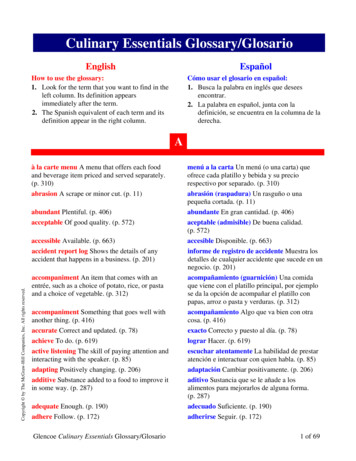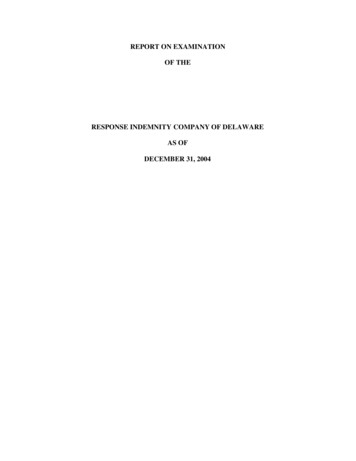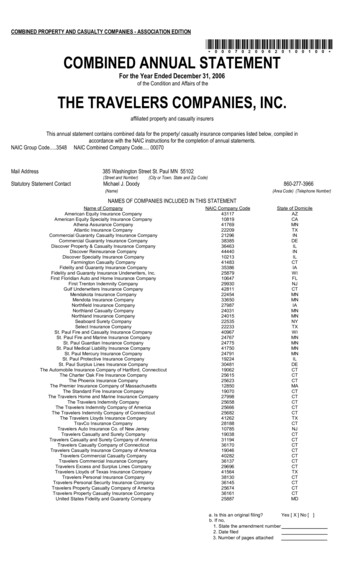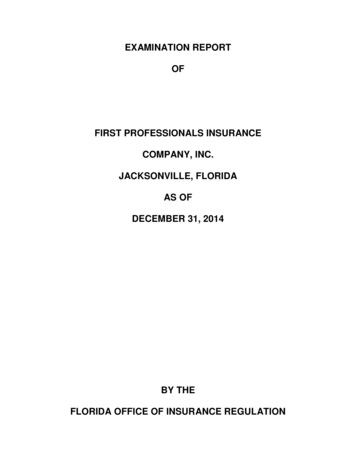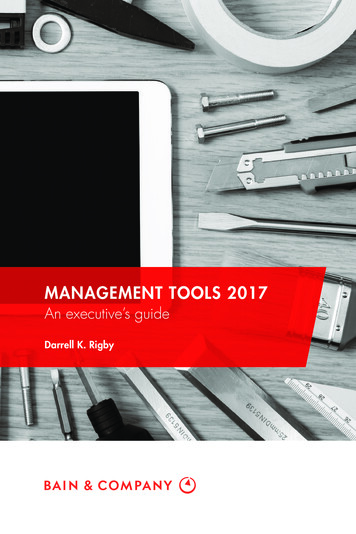
Transcription
MANAGEMENT TOOLS 2017An executive’s guideDarrell K. Rigby
MANAGEMENT TOOLS 2017An executive’s guideDarrell K. Rigby
Copyright Bain & Company, Inc. 2017All rights reserved. No part of this bookmay be reproduced in any form or by anymeans without permission in writing fromBain & Company.Published byBain & Company, Inc.131 Dartmouth StreetBoston, MA 02116
Shared Ambition, True ResultsBain & Company is the management consulting firm that the world’sbusiness leaders come to when they want results.Bain advises clients on strategy, operations, technology, organization, private equity andmergers and acquisitions. We develop practical, customized insights that clients act onand transfer skills that make change stick. Founded in 1973, Bain has 55 offices in 36countries, and our deep expertise and client roster cross every industry and economicsector. Our clients have outperformed the stock market 4 to 1.What sets us apartWe believe a consulting firm should be more than an adviser. So we put ourselves in ourclients’ shoes, selling outcomes, not projects. We align our incentives with our clients’by linking our fees to their results and collaborate to unlock the full potential of theirbusiness. Our Results Delivery process builds our clients’ capabilities, and our TrueNorth values mean we do the right thing for our clients, people and communities—always.i
OfficesNorth and South American OfficesBain & Company, Inc.3280 Peachtree Road NE, Suite 2400Atlanta, Georgia 30305tel: 1 404 869 2727Bain & Company, Inc.131 Dartmouth StreetBoston, Massachusetts 02116 USAtel: 1 617 572 2000Bain & Company ArgentinaAv del Libertador 602, 26th FoorC1001ABT Buenos Aires, Argentinatel: 54 11 4510 2600Bain & Company, Inc.190 South LaSalle Street, Suite 3400Chicago, Illinois 60603 USAtel: 1 312 541 9500Bain & Company, Inc.1717 McKinney Avenue, Suite 1700Dallas, Texas 75202 USAtel: 1 214 777 1717Bain & Company, Inc.1221 McKinney Street, Suite 3600Houston, Texas 77010 USAtel: 1 713 469 4600Bain & Company, Inc.1999 Avenue of the Stars, Suite 3800Los Angeles, California 90067 USAtel: 1 310 229 3000Bain & Company México, Inc.Paseo de Tamarindos 400A 24Bosques de las LomasMéxico, D.F. 05120 Méxicotel: 52 55 5267 1700iiBain & Company, Inc.1114 Avenue of the Americas, 43rd FloorNew York, New York 10036 USAtel: 1 646 562 8000Bain & Company, Inc.Two Palo Alto SquarePalo Alto, California 94306 USAtel: 1 650 845 3600Bain & Company BrasilAv. Republica do Chile, 500, 28th Floor20031-170 – Rio de Janeiro – RJ, Brasiltel: 55 21 3528 2300Bain & Company, Inc.One Embarcadero Center, Suite 3400San Francisco, California 94111 USAtel: 1 415 627 1000Bain & Company SantiagoAv. Apoquindo 2827, Piso 20Las Condes, Santiago, Chiletel: 56 2 2898 2000Bain & Company BrasilAv. Juscelino Kubitschek, 1.909Torre Norte, 17º andar04543-907– São Paulo – SP, Brasiltel: 55 11 3707 1200Bain & Company Canada, Inc.2 Bloor Street East, 29th FloorToronto, Ontario M4W 1A8 Canadatel: 1 416 929 1888Bain & Company DC, LLC1717 K Street NW, Suite 1100Washington, DC 20006-5346tel: 1 202 835 4600
European, Middle Eastern andAfrican OfficesBain & Company Netherlands, LLCRembrandt Tower, 25th FloorAmstelplein 11096 HA, Amsterdam, The Netherlandstel: 31 20 7107 900Bain & Company Belgium, Inc.Blue Tower, 22nd Floor1050 Brussels, Belgiumtel: 32 2 626 2626Bain & Company Denmark, ApSH.C. Andersens Blvd. 181787 Copenhagen V, Denmarktel: 45 33 410 300Bain & Company Middle East, Inc.Palm Tower B, Level 48Doha, Qatartel: 974 (4) 452 7913Bain & Company Middle East, Inc.Media One Tower, Level 36PO Box 502810Dubai, United Arab Emiratestel: 971 4 365 7 365Bain & Company Germany, Inc.Hafenspitze-Speditionstrasse 2140221 Düsseldorf, Germanytel: 49 211 42476 0Bain & Company Germany, Inc.Neue Mainzer Straße 8060311 Frankfurt, Germanytel: 49 69 667 778 0Bain & Company Finland, Inc.Eteläesplanadi 22 AFI-00130 Helsinki, Finlandtel: 358 9 6850 550Bain & Company TurkeyNispetiye CaddesiAkmerkez B 3 Blok, 10th floor34337 Etiler, Istanbul, Turkeytel: 90 212 708 1400Bain & Company South Africa, Inc.10 The High StreetMelrose Arch, 2076Johannesburg, South Africatel: 27 11 012 9100Bain & Company Ukraine, LLCRenaissance Business Center24 Bulvarno-KudriavskaKyiv, 01054 Ukrainetel: 38 044 490 70 10Bain & Company Nigeria38A Glover RdIkoyi, Lagos, Nigeriatel: 234 1 70 00 506Bain & Company, Inc. United Kingdom40 StrandLondon WC2N 5RW United Kingdomtel: 44 20 7 969 6000Bain & Company Ibérica, Inc.Paseo de la Castellana, 35, 6th floor28046, Madrid Spaintel: 34 91 790 3000Bain & Company Italy, Inc.Via Crocefisso, 1020122 Milan, Italytel: 39 02 58288 1Bain & Company Russia, LLCLotte Plaza Business Center, 15th Floor8 Novinsky BoulevardMoscow, 121099 Russiatel: 7 495 721 86 86iii
Offices (continued)Bain & Company Germany, Inc.Karlsplatz 180335 Munich, Germanytel: 49 89 5123 0Bain & Company Nordic, Inc.Dronning Mauds gate 30250 Oslo, Norwaytel: 47 22 01 82 00Bain et Compagnie SNC50 avenue Montaigne75008 Paris, Francetel: 33 1 44 55 75 75Bain & Company Saudi ArabiaITCC DevelopmentBuilding WH01-4, 3rd Floor, Unit 9Riyadh, Saudi ArabiaBain & Company Italy, Inc.Piazza Ungheria, 600198 Rome, Italytel: 39 06 8525 01Bain & Company Nordic, Inc.Regeringsgatan 38, 7th FloorSE-111 56 Stockholm, Swedentel: 46 8 412 54 00Bain & Company PolandSp. z. o.o. Warsaw Financial Center53 Emilii Plater Street00-113 Warsaw, Polandtel: 48 519 310 519Bain & Company Switzerland, Inc.Sihlporte 38001 Zurich, Switzerlandtel: 41 44 668 80 00ivAsia-Pacific OfficesBain & Company Thailand, Inc.388 Exchange TowerLevel 36, Unit 3602, Sukhumvit RoadKhwaeng Klongtoey, Khet KlongtoeyBangkok 10110 Thailandtel: 66 2 663 6700Bain & Company Greater ChinaUnit 2407-09, Office Tower 2China Central PlaceNo. 79 Jian’guo RoadChaoyang DistrictBeijing 100025, Chinatel: 86 10 5659 2888Bain & Company India Pvt. Ltd.Skav 909, 20th Floor9/1, Lavelle Road, Richmond CircleBengaluru, Karnataka 560 001 Indiatel: 91 80 6765 3800Bain & Company Greater China30/F, One International Finance Centre1 Harbour View Street, CentralHong Kongtel: 852 2978 8800PT Bain IndonesiaEquity Tower, 17th Floor, Unit DSudirman Central Business District(SCBD)Lot. 9 Jl. Jend. Sudirman Kav. 52-53Jakarta Selatan 12190Indonesiatel: 62 21 2903 7710Bain & Company Malaysia, Inc.Suite 11-1, Level 11, MENARA CIMBJalan Stesen Sentral 250470 Kuala Lumpur, Malaysiatel: 60 3 2859 9050
Bain & CompanyLevel 37120 Collins StreetMelbourne, VIC 3000 Australiatel: 61 3 8614 8000Bain & CompanyLevel 45, 1 Farrer PlaceSydney, New South Wales 2000Australiatel: 61 2 9024 8600Bain & Company India Pvt. Ltd.The Capital, 13th FloorB Wing, 1301, Plot No. C 70G Block, Bandra Kurla ComplexMumbai 400 051 Indiatel: 91 22 66289 600Bain & Company Japan, Inc.Midtown Tower, 8th Floor9-7-1 Akasaka Minato-kuTokyo 107-6208 Japantel: 81 3 4563 1100Bain & Company India Pvt. Ltd.5th Floor, Building 8, Tower ADLF Cyber City, Phase IIGurgaon, Haryana, 122 002 Indiatel: 91 124 454 1800Bain & Company, Inc.Level 40, Exchange Tower2 The EsplanadePerth WA 6000 Australiatel: 61 8 6211 3500Bain & Company Korea, Inc.24th Floor, State Tower Namsan100 Toegye-ro, Jung-guSeoul, 100-052 Koreatel: 82 2 6320 9300Bain & Company Greater China31F, 2 Plaza 66No. 1366 Nanjing West RoadJing’an District, Shanghai 200040Chinatel: 86 21 2211 5588Bain & Company Southeast Asia, Inc.38 Beach Road, Level 15South Beach TowerSingapore 189767 Singaporetel: 65 6222 0123v
Table of contentsPreface . . . . . . . . . . . . . . . . . . . . . . . . . . . . . . . . . . . . . . . . . . . . . . . . . . . 10Advanced Analytics. . . . . . . . . . . . . . . . . . . . . . . . . . . . . . . . . . . . . . . . . . . 12Related topics: Business Analytics Business Intelligence Data Mining Predictive AnalyticsAgile Management . . . . . . . . . . . . . . . . . . . . . . . . . . . . . . . . . . . . . . . . . . . 14Related topics: Iterative Innovation Lean Development DevOps Test and LearnBalanced Scorecard. . . . . . . . . . . . . . . . . . . . . . . . . . . . . . . . . . . . . . . . . . . 16Related topics: Management by Objectives Mission and Vision Statements Pay for Performance Strategic Balance SheetBenchmarking. . . . . . . . . . . . . . . . . . . . . . . . . . . . . . . . . . . . . . . . . . . . . . 18Related topics: Best Demonstrated Practices Competitor ProfilesBusiness Process Reengineering. . . . . . . . . . . . . . . . . . . . . . . . . . . . . . . . . . 20Related topics: Cycle-Time Reduction Horizontal Organizations Overhead-Value Analysis Process RedesignChange Management Programs . . . . . . . . . . . . . . . . . . . . . . . . . . . . . . . . . . 22Related topics: Cultural Transformation Organizational Change Process Redesignvi
Complexity Reduction . . . . . . . . . . . . . . . . . . . . . . . . . . . . . . . . . . . . . . . . . 24Related topics: Business Process Reengineering Decision Rights Tools Focused Strategy Repeatable Models Spans and LayersCore Competencies . . . . . . . . . . . . . . . . . . . . . . . . . . . . . . . . . . . . . . . . . . . 26Related topics: Core Capabilities Key Success FactorsCustomer Journey Analysis. . . . . . . . . . . . . . . . . . . . . . . . . . . . . . . . . . . . . . 28Related topics: Net Promoter System Advanced Analytics Customer Retention Customer Experience MappingCustomer Relationship Management . . . . . . . . . . . . . . . . . . . . . . . . . . . . . . . 30Related topics: Collaborative Commerce Customer Retention Customer Segmentation Customer Surveys Loyalty Management ToolsCustomer Satisfaction Systems . . . . . . . . . . . . . . . . . . . . . . . . . . . . . . . . . . . 32Related topics: Customer and Employee Surveys Customer Loyalty and Retention Customer Relationship Management Net Promoter Scores Revenue EnhancementCustomer Segmentation. . . . . . . . . . . . . . . . . . . . . . . . . . . . . . . . . . . . . . . . 34Related topics: Customer Surveys Market Segmentation One-to-One Marketingvii
Table of contents (continued)Digital Transformation. . . . . . . . . . . . . . . . . . . . . . . . . . . . . . . . . . . . . . . . . 36Related topics: Digital Disruption Digitization Internet of Things Digical InnovationEmployee Engagement Systems. . . . . . . . . . . . . . . . . . . . . . . . . . . . . . . . . . . 38Related topics: Employee Satisfaction Empowerment Human Resource Management Organizational CommitmentInternet of Things . . . . . . . . . . . . . . . . . . . . . . . . . . . . . . . . . . . . . . . . . . . . 40Related topics: Digital Disruption Machine Learning Internet-Connected Devices Smart DevicesMergers and Acquisitions. . . . . . . . . . . . . . . . . . . . . . . . . . . . . . . . . . . . . . . 42Related topics: Merger Integration Teams Strategic AlliancesMission and Vision Statements . . . . . . . . . . . . . . . . . . . . . . . . . . . . . . . . . . . 44Related topics: Corporate Values Statements Cultural Transformation Strategic PlanningOrganizational Time Management . . . . . . . . . . . . . . . . . . . . . . . . . . . . . . . . 46Related topics: Productivity Benchmarking Time Discipline Personal Time-Management Dashboards Talent ManagementPrice Optimization Models. . . . . . . . . . . . . . . . . . . . . . . . . . . . . . . . . . . . . . 48Related topics: Demand-Based Management Pricing Strategy Revenue Enhancementviii
Scenario and Contingency Planning. . . . . . . . . . . . . . . . . . . . . . . . . . . . . . . . 50Related topics: Crisis Management Disaster Recovery Groupthink Real-Options Analysis Simulation ModelsStrategic Alliances. . . . . . . . . . . . . . . . . . . . . . . . . . . . . . . . . . . . . . . . . . . . 52Related topics: Corporate Venturing Joint Ventures Value-Managed Relationships Virtual OrganizationsStrategic Planning. . . . . . . . . . . . . . . . . . . . . . . . . . . . . . . . . . . . . . . . . . . . 54Related topics: Core Competencies Mission and Vision Statements Scenario and Contingency PlanningSupply Chain Management. . . . . . . . . . . . . . . . . . . . . . . . . . . . . . . . . . . . . 56Related topics: Borderless Corporation Collaborative Commerce Value-Chain AnalysisTotal Quality Management. . . . . . . . . . . . . . . . . . . . . . . . . . . . . . . . . . . . . . 58Related topics: Continuous Improvement Malcolm Baldrige National Quality Award Quality Assurance Six SigmaZero-Based Budgeting. . . . . . . . . . . . . . . . . . . . . . . . . . . . . . . . . . . . . . . . . 60Related topics: Activity-Based Budgeting Complexity Reduction Cost-Benefit Analysis Performance Budgetingix
PrefaceOver the past few decades, management tools have become a common part ofexecutives’ lives. Whether they are trying to boost revenue, innovate, improvequality, increase efficiencies or plan for the future, executives search for tools tohelp them. The current environment of globalization, rapid technological advancesand economic turbulence has increased the challenges executives face and, therefore, the need to find the right tools to meet those challenges.To do this successfully, executives must be more knowledgeable than ever as they sortthrough the options and select the right management tools for their companies. Theselection process itself can be as complicated as the business issues the executivesneed to solve. They must choose the tools that will best help them make the businessdecisions that lead to enhanced processes, products and services—as well as deliversuperior performance and profits.Successful use of such tools requires an understanding of the strengths and weaknesses of each one, as well as an ability to creatively integrate the right tools in theright way at the right time. The secret is not in discovering one simple solution but inlearning which mechanisms to use and how and when to use them. In the absence ofobjective data, groundless hype makes choosing and using management tools a dangerous game of chance. To help inform managers about the tools available to them,Bain & Company launched a multiyear research project in 1993 to gather facts aboutthe use and performance of management tools. Our objective was twofold: Help managers understand how their current application of these tools and subsequent results compare with those of other organizations across industries aroundthe globeMeet the information managers’ need to identify, select, implement and integratethe optimal tools to improve their company’s performanceEvery year or two since 1993, we have conducted research to identify 25 of the mostpopular and pertinent management tools. In this guide, we define the tools and howthey are used. Through our research, we have determined the extent to which eachtool is being deployed and its rate of success.Over time, our research has provided a number of important insights. Among them: 10Overall satisfaction with tools is moderately positive, but their rates of usage, easeof implementation, effectiveness, strengths and weaknesses vary widely.Management tools are much more effective when they are part of a major organizational effort.Managers who bounce randomly from tool to tool undermine employees’ confidence.
Hyperbole surrounding the trendiest of tools often leads to unrealistic expectationsand disappointing results.Decision makers achieve better results by championing realistic strategies and viewingtools simply as a means to a strategic goal.No tool is a cure-all.In our 2015 survey, we found that managers were facing an increasingly challenging world: The majority believed that customers are less loyal to brands than they once were.Half were using advanced analytics and/or experimentation and testing techniquesto transform their marketing strategy.Two-thirds felt their spending on IT must increase as a percentage of sales.Detailed results from the Management Tools & Trends 2015 survey are available atwww.bain.com/tools.Our efforts to understand the continually evolving management tools landscape haveled us to add three new tools to this year’s guide: Agile Management, Customer JourneyAnalysis and Internet of Things. We look forward to evaluating how managers areusing these and other tools to cope with the challenges they face.We hope you find this reference guide a useful tool in itself. The insights from thisyear’s global survey will be published separately at Bain.com/publications.Darrell K. Rigby, DirectorBain & Company, Inc.11
Advanced AnalyticsRelated topicsDescription Business AnalyticsBusiness IntelligenceData MiningPredictive AnalyticsAdvanced Analytics enables the rapid extraction, transformation,loading, search, analysis and sharing of massive data sets. By analyzing a large, integrated, real-time database rather than smaller,independent, batch-processed data sets, Advanced Analyticsseeks to quickly identify previously unseen correlations andpatterns to improve decision making. Although it is related totraditional Database Management and Business Intelligencesystems, Advanced Analytics dramatically increases the abilityto process data in four major ways: Volume: moves beyond terabytes to petabytes and exabytesVelocity: enables real-time insights and actionsVariety: analyzes everything from click-stream data tovideo streamsVariability: manages changes in data formats and information fieldsThe results help managers better measure and manage the mostcritical functions of their business.MethodologyCompanies start by identifying significant business opportunities that may be enhanced by superior data and then determinewhether Advanced Analytics solutions are needed. If they are,the business will need to develop the hardware, software andtalent required to capitalize on Advanced Analytics. That oftenrequires the addition of data scientists who are skilled in askingthe right questions, identifying cost-effective information sources,finding true patterns of causality and translating analytic insightsinto actionable business information.To apply Advanced Analytics, companies should: 12Select a pilot (a business unit or functional group) with meaningful opportunities to capitalize on Advanced AnalyticsEstablish a leadership group and team of data scientists withthe skills and resources necessary to drive the effort successfullyIdentify specific decisions and actions that can be improvedDetermine the most appropriate hardware and softwaresolutions for the targeted decisions
Common usesCompanies typically use Advanced Analytics to: SelectedreferencesDecide whether to purchase or rent the systemEstablish guiding principles such as data privacy and security policiesTest, learn, share and refineDevelop repeatable models and expand applications toadditional business areasImprove internal processes, such as risk management,Customer Relationship Management, supply chain logisticsor Web content optimizationImprove existing products and servicesDevelop new product and service offeringsBetter target their offerings to their customersTransform the overall business model to capitalize on realtime information and feedbackBaesens, Bart. Analytics in a Big Data World: The Essential Guideto Data Science and Its Applications. Wiley, 2014.Brea, Cesar A. Marketing and Sales Analytics: Proven Techniquesand Powerful Applications from Industry Leaders. FT Press, 2014.Davenport, Thomas H., Jeanne G. Harris, and Robert Morison.Analytics at Work: Smarter Decisions, Better Results. HarvardBusiness Review Press, 2010.Isson, Jean-Paul, and Jesse Harriott. Win with Advanced BusinessAnalytics: Creating Business Value from Your Data. Wiley, 2012.Laursen, Gert H. N., and Jesper Thorlund. Business Analytics forManagers: Taking Business Intelligence Beyond Reporting. 2d ed. Wiley,2016.McAfee, Andrew, and Erik Brynjolfsson. “Big Data: The Management Revolution.” Harvard Business Review, October 2012.Shah, Shvetank, Andrew Horne, and Jaime Capella. “Good DataWon’t Guarantee Good Decisions.” Harvard Business Review,April 2012.Stubbs, Evan. The Value of Business Analytics: Identifying the Pathto Profitability. Wiley, 2011.13
Agile ManagementRelated topicsDescriptionMethodology Agile Management increases the value of innovation usingadaptive methods pioneered by Japanese manufacturers andpopularized by software developers. Today, executives applyAgile techniques to a broad range of activities (including innovations in products and services, processes, and businessmodels) in a wide variety of industries. Agile Managementbrings the most valuable innovations to market faster andwith lower risk while improving team engagement and customer satisfaction. Scrum is by far the most common AgileManagement approach, though methods such as Kanban, LeanDevelopment and Lean Startup are also common.How Agile Management works: 14Iterative InnovationLean DevelopmentDevOpsTest and LearnThe leadership team identifies and rigorously sequencesthe opportunities for Agile innovation.Executives assemble small, multidisciplinary, self-governingteams to address the top opportunities.An “initiative owner” works with the team to establish a vision,develop and perpetually prioritize a more detailed list ofpotential opportunities, figure out when and how to tacklethose opportunities, and ensure tangible results. A processfacilitator coaches the team in Agile methods, removesbarriers and accelerates progress.The multidisciplinary team creates a roadmap, breakscomplex problems into more manageable tasks and focuseson the most important opportunities. The team works inshort, iterative cycles (often called sprints) to create workingprototypes.Customers who are collaborating closely with the team testthe working prototypes and provide clear and rapid feedback on their true preferences. The team then adapts itsapproach to capitalize on this customer feedback.The team continually identifies opportunities to improve itseffectiveness.
Common usesCompanies use Agile Management to: SelectedreferencesShift leadership’s time and focus from micromanagingto strategizingFrequently adapt their strategy to capitalize on changingconditionsIncrease focus and reduce multitaskingEliminate low-value work and other forms of wasteBetter manage changeCultivate breakthrough innovation in areas ranging fromnew product development and marketing to supply chainimprovementCobb, Charles G. The Project Manager’s Guide to Mastering Agile:Principles and Practices for an Adaptive Approach. Wiley, 2015.Cohn, Mike. Agile Estimating and Planning. Prentice Hall, 2005.Reinertsen, Donald G. The Principles of Product DevelopmentFlow: Second Generation Lean Product Development. CeleritasPublishing, 2009.Ries, Eric. The Lean Startup. Crown Publishing Group, 2011.Rigby, Darrell K., Jeff Sutherland, and Hirotaka Takeuchi.“Embracing Agile.” Harvard Business Review, May 2016, pp. 40–50.Rubin, Kenneth S. Essential Scrum: A Practical Guide to theMost Popular Agile Process. Addison-Wesley Professional, 2012.Sutherland, Jeff, and J.J. Sutherland. Scrum: The Art of DoingTwice the Work in Half the Time. Crown Business, 2014.15
Balanced ScorecardRelated topicsDescription A Balanced Scorecard defines an organization’s performanceand measures whether management is achieving desired results.The Balanced Scorecard translates Mission and Vision Statementsinto a comprehensive set of objectives and performance measuresthat can be quantified and appraised. These measures typicallyinclude the following categories of performance: MethodologyFinancial performance (revenues, earnings, return on capital,cash flow)Customer value performance (market share, customer satisfaction measures, customer loyalty)Internal business process performance (productivity rates,quality measures, timeliness)Innovation performance (percentage of revenue from newproducts, employee suggestions, rate of improvement index)Employee performance (morale, knowledge, turnover, useof best demonstrated practices)To construct and implement a Balanced Scorecard,managers should: 16Management by ObjectivesMission and Vision StatementsPay for PerformanceStrategic Balance SheetArticulate the business’s vision and strategyIdentify the performance categories that best link the business’s vision and strategy to its results (such as financial performance, operations, innovation, employee performance)Establish objectives that support the business’s visionand strategyDevelop effective measures and meaningful standards, establishing both short-term milestones and long-term targetsEnsure companywide acceptance of the measuresCreate appropriate budgeting, tracking, communicationand reward systemsCollect and analyze performance data and compare actualresults with desired performanceTake action to close unfavorable gaps
Common usesA Balanced Scorecard is used to: SelectedreferencesClarify or update a business’s strategyLink strategic objectives to long-term targets andannual budgetsTrack the key elements of the business strategyIncorporate strategic objectives into resourceallocation processesFacilitate organizational changeCompare performance of geographically diversebusiness unitsIncrease companywide understanding of the corporate visionand strategyEpstein, Marc, and Jean-François Manzoni. “Implementing Corporate Strategy: From Tableaux de Bord to Balanced Scorecards.”European Management Journal, April 1998, pp. 190–203.Kaplan, Robert S., and David P. Norton. Alignment: Using theBalanced Scorecard to Create Corporate Synergies. Harvard Business School Press, 2006.Kaplan, Robert S., and David P. Norton. “The Balanced Scorecard:Measures That Drive Performance.” Harvard Business Review,July 2005, pp. 71–79.Kaplan, Robert S., and David P. Norton. Strategy Maps: ConvertingIntangible Assets into Tangible Outcomes. Harvard Business SchoolPress, 2004.Kaplan, Robert S., and David P. Norton. The Strategy-FocusedOrganization: How Balanced Scorecard Companies Thrive in theNew Business Environment. Harvard Business School Press, 2000.Niven, Paul R. Balanced Scorecard Diagnostics: Maintaining MaximumPerformance. John Wiley & Sons, 2005.Niven, Paul R. Balanced Scorecard Evolution: A Dynamic Approachto Strategy Execution. John Wiley & Sons, 2014.Niven, Paul R. Balanced Scorecard Step-by-Step: Maximizing Performance and Maintaining Results. 2d ed. John Wiley & Sons, 2006.17
BenchmarkingRelated topicsDescriptionMethodology Benchmarking improves performance by identifying and applying best demonstrated practices to operations and sales. Managers compare the performance of their products or processesexternally with those of competitors and best-in-class companies,and internally with other operations that perform similar activities in their own firms. The objective of Benchmarking is tofind examples of superior performance and understand the processes and practices driving that performance. Companies thenimprove their performance by tailoring and incorporating thesebest practices into their own operations—not by imitating, butby innovating.Benchmarking involves the following steps: Common usesSelect a product, service or process to benchmarkIdentify the key performance metricsChoose companies or internal areas to benchmarkCollect data on performance and practicesAnalyze the data and identify opportunities for improvementAdapt and implement the best practices, setting reasonablegoals and ensuring companywide acceptanceCompanies use Benchmarking to: 18Best Demonstrated PracticesCompetitor ProfilesImprove performance. Benchmarking identifies methods ofimproving operational efficiency and product design.Understand relative cost position. Benchmarking reveals acompany’s relative cost position and identifies opportunitiesfor improvement.Gain strategic advantage. Benchmarking helps companies focus on capabilities that are critical to building strategic advantage.Increase the rate of organizational learning. Benchmarkingbrings new ideas into the company and facilitates experience sharing.
SelectedreferencesAmerican Productivity and Quality Center. www.apqc.orgBogan, Christopher E., and Michael J. English. Benchmarking forBest Practices: Winning Through Innovative Adaptation. McGrawHill, 1994.Boxwell, Robert J., Jr. Benchmarking for Competitive Advantage.McGraw-Hill, 1994.Camp, Robert C. Benchmarking: The Search for Industry Best Practices That Lead to Superior Performance. Productivity Press, 2006.Coers, Mardi, Chris Gardner, Lisa Higgins, and Cynthia Raybourn.Benchmarking: A Guide for Your Journey to Best-Practice Processes.American Productivity and Quality Center, 2001.Czarnecki, Mark T. Managing by Measuring: How to ImproveYour Organization’s Performance Through Effective Benchmarking.AMACOM, 1999.Denrell, Jerker. “Selection Bias and the Perils of Benchmarking.”Harvard Business Review, April 2005, pp. 114–119.Harrington, H. James. The Complete Benchmarking ImplementationGuide: Total Benchmarking Management. McGraw-Hill, 1996.Iacobucci, Dawn, and Christie Nordhielm. “Creative Benchmarking.”Harvard Business Review, November/December 2000, pp. 24–25.Lane, Leonard. The Power of Benchmarking. Lexingford Publishing,2016.Reider, Rob. Benchmarking Strategies: A Tool for Profit Improvement.John Wiley & Sons, 2000.Stauffer, David. “Is Your Benchmarking Doing the Right Work?”Harvard Management Update, September 2003, pp. 1–4.19
Business Process ReengineeringRelated topics Cycle-Time ReductionHorizontal OrganizationsOverhead-Value AnalysisProcess RedesignDescriptionBusiness Process Reengineering involves the radical redesign ofcore business processes to achieve dramatic improvements inproductivity, cycle times and quality. In Business Process Reengineering, companies start with a blank sheet of paper and rethink existing processes to deliver more value to the customer.They typically adopt a new value system that places increasedemphasis on customer needs. Companies re
ii Offices North and South American Offices Bain & Company, Inc. New York, New York 10036 U
